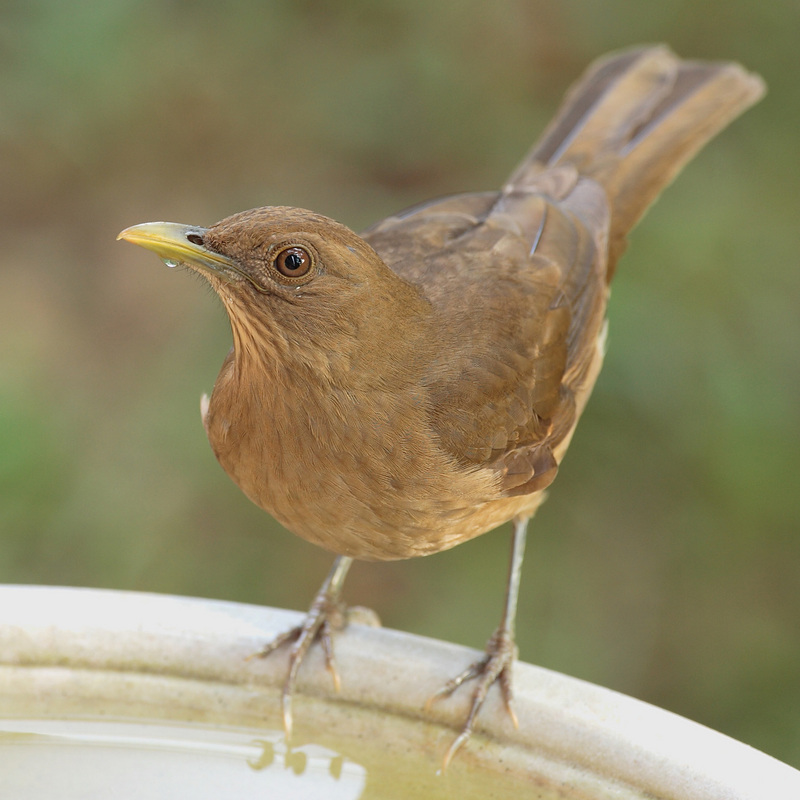|
| 질의: grey thrush | 결과: 54번째/88 | |
Clay-colored Robin (Turdus grayi) - Wiki
| 제목: | Clay-colored Robin (Turdus grayi) - Wiki
| |

| 해상도: 1536x1536
파일크기: 421803 Bytes
촬영일: 2005:12:07 21:40:25
사진기: Canon EOS-1D Mark II (Canon)
F number: f/5.7
Exposure: 1/30 sec
Focal Length: 500/1
등록시간: 2008:02:02 00:19:45
|
Clay-colored Robin
From Wikipedia, the free encyclopedia
Order: Passeriformes
Family: Turdidae
[Photo] Clay-colored Robin (Turdus-grayi) Panama City, Panama. Date: 2005 December. Photograph: Mdf (http://en.wikipedia.org/wiki/User:Mdf) | Permission is granted to copy, distribute and/or modify this document under the terms of the GNU Free Documentation License, Version 1.2 or any later version published by the Free Software Foundation; with no Invariant Sections, no Front-Cover Texts, and no Back-Cover Texts. A copy of the license is included in the section entitled "GNU Free Documentation License". |
The Clay-colored Robin or Clay-colored Thrush (Turdus grayi) is a common Central American bird of the thrush family (Turdidae|). It is the national bird of Costa Rica, where it is well known as the yigüirro.
It ranges from northeastern Mexico to northern Colombia; west and north of the Isthmus of Tehuantepec it is limited to the Atlantic slope, except for a population around Oaxaca City that probably originates from escaped cagebirds. It occurs rarely in south Texas, mostly in winter, and has bred there. Its habitat is open areas with trees or hedges and forest edges.
Description
In general appearance and habits it resembles other Turdus thrushes such as the American Robin. It is about the same length or slightly smaller: 23–27 cm (9–10.5 in), and weighs 74–76 g (2.6 oz.) on average. The plumage is brownish, somewhat lighter below than above, lightest on the flanks. Birds from humid regions are darker than those from dry regions. The throat is faintly streaked. Immature birds have faint mottling on the back and underparts. The bill is greenish-yellow with a dark base, the legs are pinkish or flesh-colored, and the irises are reddish – all useful identification points.
The song, rather low-pitched and with a slow steady tempo, consists of many slurred musical phrases which are often repeated irregularly. The tock flight call is like the American Robin's but harsher.
Ecology
In much of its range it is familiar in yards and gardens, similar to some other thrushes such as the American Robin, the Eurasian Blackbird, and the Song Thrush. In 1977 the Costa Ricans chose the yigüirro (over many much more colorful birds that inhabit the country) as a tribute to its strong and melodious song that always comes during the start of the rainy season. In addition, unlike many of the forest songsters of Costa Rica, the present bird has been familiar to the general population since the country's early history, thanks to the species' tendency to live near houses and settlements.
The Clay-colored Robin usually forages for fruit or invertebrates on the ground or near it, singly or in pairs, but flocks may feed high in fruiting trees. It will follow army ants to feed on small prey disturbed by the ant columns.
It builds a heavy cup nest of grass, moss, and mud on a firm support above the ground, which may include human constructions such as windowsills. It lays 2 to 4 pale blue eggs with red-brown and gray markings between March and July and may double-brood. It is aggressive in defense of its nest, but is not otherwise particularly territorial.
http://en.wikipedia.org/wiki/Clay-colored_Robin
| The text in this page is based on the copyrighted Wikipedia article shown in above URL. It is used under the GNU Free Documentation License. You may redistribute it, verbatim or modified, providing that you comply with the terms of the GFDL. |
|
^o^
동물그림창고 똑똑전화 누리집
^o^
|
|

